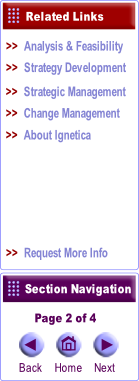


Copyright © 2003-

Be in the successful 20%
Over 78% of all strategic initiative and change programmes fail to deliver the benefits anticipated: The statistics might be alarming, but the message is clear. The Gap between delivered strategic performance and expectation is considerable, very considerable!
When put into the context of how important delivery of strategy is both to organisations competitive capability, shareholder value and ultimately survival, the need to be in the 22% successfully delivering strategy is clear. The good news is we can help and our personnel have a long track record of consistently ensuring successful strategy delivery.
So what are the key elements of success? No matter how good a strategy, if it isn’t implemented effectively it will fail to realise the anticipated benefits. But equally if the strategy isn’t properly developed in the first place, no matter how good the implementation it too will fail to achieve the desired outcomes. The key is to get both elements right - the strategy and the implementation.
It starts with Analysis: Development of Strategy is built on the understanding of ones environment, both now and where you expect it to be in the future. If the underlying analysis and forecasting is flawed or biased, the consequent strategy will be flawed. Absolute clarity and objectivity devoid of any biasing factors is an essential starting point.
It’s in the Synthesis: Development of good and effective strategy isn’t simple, it needs to be borne from the synthesis of multiple driving factors bound by underlying constraints and grounded in absolute reality. Strategy is about getting from where you are to where you want to be more effectively than your competition. Its about beating* the competition in profitably servicing your market(s), and its ultimately about generation of value. Strategy is not just about you. It’s much more about the environment. Playing to your strengths (or developing those you need), mitigating your weaknesses is great but is also about avoiding others strengths and exploiting their weaknesses. *It can also be about changing the game and avoiding traditional competition. All of these factors and many more need to inform the development of effective strategy.
Translation into Reality: Moving strategy off the page and brining it to life within your organisation is the real challenge. No matter how good the earlier stages, if this isn’t effective, strategy remains a nice document to show people and to review next year! With the pace of change in almost all industries continuing to increase, no organisation can afford poor strategic performance. How strategy is deployed depends entirely on the organisation. The needs for example of a SME are very different to a large Corporate. They key in all instances is getting strategy on the agenda, owned and
Over 78% of all strategic initiative and change programmes fail to deliver the benefits anticipated: The statistics might be alarming, but the message is clear. The Gap between delivered strategic performance and expectation is considerable, very considerable!
When put into the context of how important delivery of strategy is both to organisations competitive capability, shareholder value and ultimately survival, the need to be in the 22% successfully delivering strategy is clear. The good news is we can help and our personnel have a long track record of consistently ensuring successful strategy delivery.
So what are the key elements of success? No matter how good a strategy, if it isn’t implemented effectively it will fail to realise the anticipated benefits. But equally if the strategy isn’t properly developed in the first place, no matter how good the implementation it too will fail to achieve the desired outcomes. The key is to get both elements right -
It starts with Analysis: Development of Strategy is built on the understanding of ones environment, both now and where you expect it to be in the future. If the underlying analysis and forecasting is flawed or biased, the consequent strategy will be flawed. Absolute clarity and objectivity devoid of any biasing factors is an essential starting point.
It’s in the Synthesis: Development of good and effective strategy isn’t simple, it needs to be borne from the synthesis of multiple driving factors bound by underlying constraints and grounded in absolute reality. Strategy is about getting from where you are to where you want to be more effectively than your competition. Its about beating* the competition in profitably servicing your market(s), and its ultimately about generation of value. Strategy is not just about you. It’s much more about the environment. Playing to your strengths (or developing those you need), mitigating your weaknesses is great but is also about avoiding others strengths and exploiting their weaknesses. *It can also be about changing the game and avoiding traditional competition. All of these factors and many more need to inform the development of effective strategy.
Translation into Reality: Moving strategy off the page and brining it to life within your organisation is the real challenge. No matter how good the earlier stages, if this isn’t effective, strategy remains a nice document to show people and to review next year! With the pace of change in almost all industries continuing to increase, no organisation can afford poor strategic performance. How strategy is deployed depends entirely on the organisation. The needs for example of a SME are very different to a large Corporate. They key in all instances is getting strategy on the agenda, owned and

